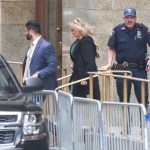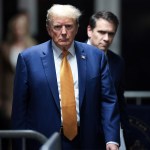Aaron Brown valiantly tries to carry the CNN ball into the credibility endzone, only to get dragged back by unnamed goofball colleagues who put together this piece on the CNN website.
As many of you now know, Brown had former chief weapons inspector David Kay on his show this evening and gave a rather conclusive presentation about the significance of the videotapes shot by embeds with the 101st Airborne, which clearly show large quantities of the explosives in question at al Qaqaa as late as April 18th, 2003.
They even have footage of the IAEA seal being clipped off the warehouses as they’re going in.
Listen to what Kay said when Brown asked him whether the debate over when the explosives were taken is now over …
Well, at least with regard to this one bunker, and the film shows one seal, one bunker, one group of soldiers going through, and there were others there that were sealed. With this one, I think it is game, set, and match. There was HMX, RDX in there. The seal was broken. And quite frankly, to me the most frightening thing is not only was the seal broken, lock broken, but the soldiers left after opening it up. I mean, to rephrase the so-called pottery barn rule. If you open an arms bunker, you own it. You have to provide security.
Now, note one other thing. Kay is quite cautious in noting that it’s only a slam dunk for the one bunker that appears in the video he’s being shown.
But look at what one of the reporters who was there when the video was shot said earlier Thursday evening on Paula Zahn’s show …
Well, I should be clear. I don’t think — I’m not saying for a minute that I know that the munitions and the explosives that we stumbled upon were in fact the munitions or the explosives in question.
All I can say with certainty is that, on that day, there were bunker after bunker after bunker of explosives, tons of them, that were unguarded. We went in and looked at some of them. I don’t have the sort of expertise to tell you whether or not those were exactly what they’re talking about when they say that these — how many odd tons of explosives went missing.
So, apparently, there was bunker after bunker with the same stuff Kay was sure about in the one bunker he saw video of.
And now look how CNN plays the story on their website in the early hours of Friday morning (emphasis added) …
Two more bits of possible evidence surfaced Thursday in the mystery of the missing Iraqi explosives, but they appear to bolster two different scenarios as to what may have happened to the cache.
The Pentagon released a photo showing activity before the U.S.-led invasion of Iraq in March 2003 outside a bunker at the weapons dump where nearly 380 tons of explosives reportedly disappeared.
While the photo might lend support to but does not prove the Pentagon’s theory that the high-grade explosives were moved before the war, a videotape surfaced offering another scenario.
The video, shot by a crew from KSTP-TV in Minneapolis, Minnesota, that was embedded with the 101st Airborne Division, showed barrels of explosives in unguarded bunkers in the Al Qaqaa complex on April 18, 2003, nine days after the fall of Baghdad.
It was unclear, however, if the explosives in the video were of the same types as in the missing cache.
The Pentagon evidence in question is a piece of aerial photography showing two trucks near an al Qaqaa bunker in mid-March 2003. That’s it. As part of some larger argument or larger body of evidence this might be suggestive evidence. But alone it means next to nothing. On top of that, the highly-respected globalsecurity.org website says they’re not even the right bunkers.
And yet to CNN, it’s just a he said/she said, two “bits of possible evidence” as they put it, pointing to “different scenarios.” And for them the aerial photos are actually the more probative evidence, as evidenced by the structure of the sentence in the third graf above.
And then there’s that last line: “It was unclear, however, if the explosives in the video were of the same types as in the missing cache.”
Really?
Who wrote that line and where do they get their information? Apparently not from CNN or ABC.
Listen to what Kay said when asked about this by Brown …
AB: Was there anything else at the facility that would have been under IAEA seal?
DK: Absolutely nothing. It was the HMX, RDX, the two high explosives.
And then a moment later …
HMX is in powder form because you actually use it to shape a spherical lens that is used to create the triggering device for nuclear weapons. And particularly on the videotape, which is actually better than the still photos, as the soldier dips into it, that’s either HMX or RDX. I don’t know of anything else in al Qaqaa that was in that form.
Whatever else you can say about him, David Kay knows a thing or two about this subject. And he seems positive.
And look what fellow inspector David Albright told ABC …
Experts who have studied the images say the barrels on the tape contain the high explosive HMX, and the U.N. markings on the barrels are clear.
“I talked to a former inspector who’s a colleague of mine, and he confirmed that, indeed, these pictures look just like what he remembers seeing inside those bunkers,” said David Albright, president of the Institute for Science and International Security in Washington.
The Times even has this from a piece that went up late Thursday evening: “Weapons experts familiar with the work of the international inspectors in Iraq say the videotape appears identical to photographs that the inspectors took of the explosives, which were put under seal before the war.”
Apparently, at least three weapons inspectors — probably more, including the Times — are certain that’s the material in question. But to the folks at CNN it’s still an open question.
They seem to want to play by the White House rules, under which each separate ton of explosive material must be identified in videotapes from embeds and then certified as authentic by every conceivable expert under the sun before the president will have to admit that maybe something went wrong.
And of course no one can bring the issue up in a political context until the presidential commission Jeb Bush appoints in 2010 comes back with its final report two years later.
Late Update: As of this morning (10:03 AM), the CNN webscribes did a fairly aggressive edit on this piece. I’ve got to start saving copies of these articles before the inevitable switcheroo.






